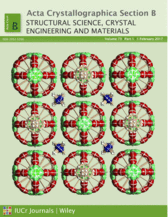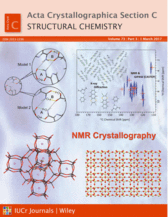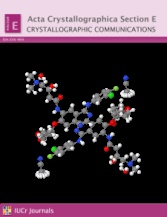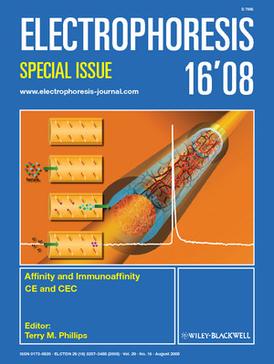Journals
Acta Crystallographica Section A
 | |
| Discipline | Crystallography |
|---|---|
| Language | English |
| Edited by |
|
| Publication details | |
Former name(s) | Acta Crystallographica Section A: Crystal Physics, Diffraction, Theoretical and General Crystallography Acta Crystallographica Section A: Foundations of Crystallography |
| History | 1968-present |
| Publisher | IUCr/Wiley |
| Frequency | Bimonthly |
| Hybrid | |
| 2.290 (2020) | |
| Standard abbreviations | |
| ISO 4 | Acta Crystallogr. A |
| Indexing | |
| CODEN | ACSAD7 |
| ISSN | 2053-2733 |
| Links | |
Acta Crystallographica Section A: Foundations and Advances is the foundation on which the whole suite of IUCr crystallography journals are built, containing papers describing fundamental developments in crystallographic theory and practice. [12] When Acta Crystallographica was split into two sections in 1967, Section A was named Acta Crystallographica Section A: Crystal Physics, Diffraction, Theoretical and General Crystallography. The journal's name changed again in 1982 to Acta Crystallographica Section A: Foundations of Crystallography. [13] The journal adopted its current title in 2013.
Abstracting and indexing
The journal is abstracted and indexed in:
- Biological Abstracts
- Cambridge Structural Database
- Ceramic Abstracts
- Chemical Abstracts Service
- Chemistry Citation Index
- Current Chemical Reactions Database
- Current Contents/ Physical, Chemical and Earth Sciences
- Inorganic Crystal Structure Database
- Inspec
- ISI Chemistry Reaction Center
- Medline
- Metals Abstracts/METADEX
- Materials Science Citation Index
- Reaction Citation Index
- Research Alert
- Science Citation Index
- Science Citation Index Expanded
- SCISEARCH
- Scopus
Acta Crystallographica Section B
 | |
| Discipline | Crystallography |
|---|---|
| Language | English |
| Edited by |
|
| Publication details | |
Former name(s) | Acta Crystallographica. Section B: Structural Crystallography and Crystal Chemistry Acta Crystallographica Section B: Structural Science |
| History | 1968-present |
| Publisher | IUCr/Wiley |
| Frequency | Bimonthly |
| Hybrid | |
| 2.266 (2020) | |
| Standard abbreviations | |
| ISO 4 | Acta Crystallogr. B |
| Indexing | |
| CODEN | ACSBDA |
| ISSN | 2052-5206 |
| Links | |
Acta Crystallographica Section B: Structural Science, Crystal Engineering and Materials publishes scientific articles on structural science. [14] [15] According to the journal: "Knowledge of the arrangements of atoms, including their temporal variations and dependencies on temperature and pressure, is often the key to understanding physical and chemical phenomena and is crucial for the design of new materials and supramolecular devices." [15] It was formed in 1968 when the journal Acta Crystallographica was split into two parts and has been published for the International Union of Crystallography under the following titles:
- Acta Crystallographica. Section B: Structural Crystallography and Crystal Chemistry ( ISSN 0567-7408) from its formation until the end of 1982. It was published in Denmark by Munksgaard and accepted articles in English, French, and German. [16]
- On the launch of Acta Crystallographica Section C in 1983, the title of Section B changed to Acta Crystallographica Section B: Structural Science ( ISSN 0108-7681), and the publisher was changed to Wiley-Blackwell in 2004 [17] after Wiley had acquired Munksgaard.
- From the start of 2013, the title was changed to the present Acta Crystallographica Section B: Structural Science, Crystal Engineering and Materials ( ISSN 2052-5192) and the journal now only publishes in English. [18]
Abstracting and indexing
The journal is abstracted and indexed in:
- Biological Abstracts
- Cambridge Structural Database
- Ceramic Abstracts
- Chemical Abstracts Service
- Chemistry Citation Index
- Current Chemical Reactions Database
- Current Contents/ Physical, Chemical and Earth Sciences
- Inorganic Crystal Structure Database
- Inspec
- ISI Chemistry Reaction Center
- Medline
- Metals Abstracts/METADEX
- Materials Science Citation Index
- Nucleic Acid Database
- Protein Data Bank
- Reaction Citation Index
- Research Alert
- Science Citation Index
- Science Citation Index Expanded
- SCISEARCH
- Scopus
Acta Crystallographica Section C
 | |
| Discipline | Crystallography |
|---|---|
| Language | English |
| Edited by |
|
| Publication details | |
Former name(s) | Acta Crystallographica Section C: Crystal Structure Communications |
| History | 1983-present |
| Publisher | IUCr/Wiley |
| Frequency | Monthly |
| Hybrid | |
| 1.172 (2020) | |
| Standard abbreviations | |
| ISO 4 | Acta Crystallogr. C |
| Indexing | |
| CODEN | ACSCGG |
| ISSN | 2053-2296 |
| Links | |
Acta Crystallographica Section C: Structural Chemistry is a journal for the rapid publication of research with structural content relating to the chemical sciences. [19]
Abstracting and indexing
The journal is abstracted and indexed in:
- Biological Abstracts
- Cambridge Structural Database
- Ceramic Abstracts
- Chemical Abstracts Service
- Chemistry Citation Index
- Current Chemical Reactions Database
- Current Contents/ Physical, Chemical and Earth Sciences
- Inorganic Crystal Structure Database
- Inspec
- ISI Chemistry Reaction Center
- Medline
- Metals Abstracts/METADEX
- Materials Science Citation Index
- Reaction Citation Index
- Research Alert
- Science Citation Index
- Science Citation Index Expanded
- SCISEARCH
- Scopus
Acta Crystallographica Section D
 | |
| Discipline | |
|---|---|
| Language | English |
| Edited by |
|
| Publication details | |
Former name(s) | Acta Crystallographica Section D: Biological Crystallography |
| History | 1993–present |
| Publisher | IUCr/Wiley |
| Frequency | Monthly |
| Hybrid | |
| 7.652 (2020) | |
| Standard abbreviations | |
| ISO 4 | Acta Crystallogr. D |
| Indexing | |
| CODEN | ACSDAD |
| ISSN | 2059-7983 |
| Links | |
Acta Crystallographica Section D: Structural Biology publishes articles covering all areas of structural biology, including biomolecular structures determined by NMR and cryo-EM as well as crystallography, and the methods used to obtain them. [20] The journal was launched in 1993 as Acta Crystallographica Section D: Biological Crystallography with Jenny Glusker as the founding Editor. In 2003, Ted Baker and Zbigniew Dauter took over the editorship of the journal. [21] The current Editors are Elspeth Garman, Randy J. Read and Charles S. Bond. In 2016, the title was changed to Acta Crystallographica Section D: Structural Biology to reflect the expanded scope of the journal.
Abstracting and indexing
The journal is abstracted and indexed in:
- Biochemistry and Biophysics Citation Index
- Biological Abstracts
- BIOSIS Previews
- Cambridge Structural Database
- Ceramic Abstracts
- Chemical Abstracts Service
- Chemistry Citation Index
- Current Contents/ Life Sciences
- Inorganic Crystal Structure Database
- Inspec
- Medline
- Metals Abstracts/METADEX
- Nucleic Acid Database
- Protein Data Bank
- Research Alert
- Science Citation Index
- Science Citation Index Expanded
- SCISEARCH
- Scopus
Acta Crystallographica Section E
 | |
| Discipline | Crystallography |
|---|---|
| Language | English |
| Edited by |
|
| Publication details | |
Former name(s) | Acta Crystallographica Section E: Structure Reports Online |
| History | 2001-present |
| Publisher | IUCr/Wiley |
| Frequency | Monthly |
| Yes | |
| 0.347 (2011) | |
| Standard abbreviations | |
| ISO 4 | Acta Crystallogr. E |
| Indexing | |
| CODEN | ACSECI |
| ISSN | 2056-9890 |
| Links | |
Acta Crystallographica Section E: Crystallographic Communications is an open-access structural communications journal. It reports crystal structure determinations of inorganic, metal-organic and organic compounds. [22] Since 2012, Acta Crystallogr. E has not been included in the Science Citation Index.
Abstracting and indexing
The journal is abstracted and indexed in:
Acta Crystallographica Section F
 | |
| Discipline | Crystallography |
|---|---|
| Language | English |
| Edited by |
|
| Publication details | |
Former name(s) | Acta Crystallographica Section F: Structural Biology and Crystallization Communications |
| History | 2005–present |
| Publisher | IUCr/Wiley |
| Frequency | Monthly |
| Hybrid | |
| 1.056 (2020) | |
| Standard abbreviations | |
| ISO 4 | Acta Crystallogr. F |
| Indexing | |
| CODEN | ACSFEN |
| ISSN | 2053-230X |
| Links | |
Acta Crystallographica Section F is a rapid structural biology communications journal. It publishes short papers on biological structures and any aspects of structural biology. [23]
Abstracting and indexing
The journal is abstracted and indexed in:










